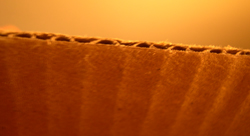Cardboard
|
|
Cardboard (called corrugated paper in the industry) is a heavy wood-based type of paper, notable for its stiffness and durability. It was first invented in China some time in the 15th century, and is used for a wide variety of purposes. One of its more common uses is as a packaging material.
History
The first commercial cardboard box was produced in England in 1817 [1] (http://ohioline.osu.edu/cd%2Dfact/0133.html).
In the mid 19th century, an ingenious concept enabled flimsy sheets of paper to be transformed into a rigid, stackable and cushioning form of packaging for delicate goods in transit. Corrugated (also called pleated) paper was patented in England in 1856, used as a liner for tall hats, but corrugated cardboard would not be patented and used as a shipping material until December 20, 1871. The patent was issued to Albert Jones of New York, New York for single-sided corrugated cardboard. Jones used the corrugated cardboard for wrapping bottles and glass lantern chimneys. The first machine for producing large quantities of corrugated cardboard was built in 1874 by G. Smyth, and in the same year Oliver Long improved upon Jones' design by inventing corrugated cardboard with liner sheets on both sides. This was now corrugated cardboard as we know it today.
The American Robert Gair invented the corrugated cardboard box in 1890, consisting of pre-cut flat pieces manufactured in bulk that folded into boxes. Gair's invention, as with so many other great innovations, came about as a result of an accident; he was a Brooklyn printer and paper-bag maker during the 1870s, and while he was printing an order of seed bags a metal ruler normally used to crease bags shifted in position and cut the bag. Gair discovered that by cutting and creasing cardboard in one operation he could make prefabricated cartons. Extending this to corrugated cardboard was a straightforward development when the material became available. By the start of the 20th century, corrugated cardboard boxes began replacing the custom-made wooden crates and boxes previously used for trade.
Will Keith Kellogg first used cardboard cartons to hold flaked corn cereal, and later when he began marketing it to the general public, a heat-sealed waxed bag of Waxtite was wrapped around the outside of the box and printed with their brand name. This marked the origin of the cereal box, though in modern times the sealed bag is plastic and is kept inside the box rather than outside.
Corrugated packaging has undergone a minor resurgence in recent times due to the trend towards environmentalism. It is now common for cardboard to be manufactured with a partial content of recycled fibers.
Today's corrugated cardboard
Today's corrugated board usually consists of outer flat sheets (liners) of puncture resistant paper, sandwiching a central "filling" of corrugated short fibre paper (fluting medium), which resists crushing under compression and gives cushioning protection to the box's contents. The board has high end-to-end strength along the corrugated flutes, so the box is normally designed with the flutes running vertically for stacking strength. Paper made from hardwood, short fibre pulp has good compression strength and is easily mouldable with moisture and heat, but is weak in tension and tears easily. Paper made from softwoods, with their longer fibres, on the other hand, is strong in tension and resists puncturing and tearing better and is less plastic, so tends to keep its shape. It also provides a better surface for printing.
The liners and corrugated medium are glued together along the outsides of the peaks and valleys of each flute, normally using starch adhesives. The starch is derived from corn, wheat or potato. Thus the complete make-up of corrugated board is from natural, sustainable materials in plentiful supply and the board is fully recyclable and can be pulped down to make more paper for more board once it has ended its own life. It is a highly ecologically friendly material.
The corrugated case was initially developed for packaging glass and pottery containers, which are easily broken in transit. Then they enabled fruit and produce to be brought from the farm to the retailer without bruising, so improving the return to the producers and opening up hitherto unaffordable export markets. Imagine the waste when oranges, for example, were craned out of the hold of a ship, having been bulk loaded into it.
Nowadays, double and triple "sandwiches" of heavy duty board are made for industrial applications, while at the other extreme, microflute board is made for finely printed packaging or display work or presentation packs of high value contents such as spirits, perfume, jewellery etc. Almost all corrugated cases are made for folding flat for ease and economy of transport, then erected, filled and closed at the packing station.
Old corrugated cases are an excellent source of fibre for recycling. They can be compressed and baled for cost effective transport to anywhere in need of fibre for papermaking. Thus they help developing countries without much afforestation to build a paper and packaging industry locally and develop their exports to global markets.
Corrugated board is made on heavy high precision machinery lines called corrugators. Various types of "converting" machines are used in making the boxes out of the board produced from the corrugator and printing them. A box factory can be started with simple equipment and added to as the market expands and growth is affordable.
External links
- Corrugated Packaging Council (CPC) (http://www.corrugated.org/)da:Karton (papir)

